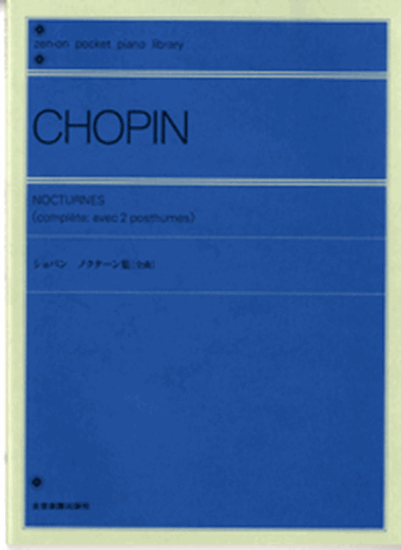Chopin, Frederic : Nocturne No.18 E-Dur Op.62-2
Work Overview
Genre:nocturne
Total Playing Time:5 min 00 sec
Copyright:Public Domain
Commentary (1)
Author : Ueda, Yasushi
Last Updated: January 1, 2010
[Open]
Author : Ueda, Yasushi
Deux Nocturnes Op.62
These two pieces were composed in 1846, and their first editions were published in Paris (Brandus, 1846), Leipzig (Breitkopf und Härtel, 1846), and London (Wessel, 1846). They are dedicated to Miss R. von Heygendorff-Kenneritz, who is believed to have been his pupil. These are the last nocturnes published by Chopin during his lifetime. Compared to the two pieces of Op. 55, the writing becomes increasingly polyphonic, the chromatic undulations disappear, and the sound gains transparency. At this point, he seems to have reconciled the polyphonic writing he had always yearned for with the lyrical style, finding his own answer.
No. 2 in E Major
The accompaniment figuration in No. 2 is the same as that used previously in Op. 55-1 and Op. 48-1, consisting of chords filling the bass and middle voices. This creates a rich and broad sound. The form, like other nocturnes, is a three-part (ternary) form.
This nocturne is framed by two characteristic harmonic progressions. In the opening measure, the passing chord on the second beat is a VI degree (E-G#-C#), which immediately resolves to the I degree ([E]-B-G#) on the third beat. When this chord on the second beat is used at the beginning, and moreover at a slow tempo like Lento, it evokes the sound of French modernism. This opening progression can also be heard in the cadenza of the final measure, suggesting intentional use.
The main theme section (hereafter A), which continues until measure 32, does not exhibit the same polyphony as No. 1, but the brilliant ornamental figuration in the right hand, seen when the theme is repeated in measure 25, is a commonality with No. 1.
The subsequent middle section (measures 32-57) begins with a wavy figuration in the right hand. This treatment of the left hand, as seen in 12 Etudes, Op. 10-12 and Kalkbrenner's etudes, is a type of writing for left-hand training used by pioneering pianists around the 1830s. Of course, Chopin uses this technique not so much for left-hand training, but rather to introduce a change in the atmosphere established in section A and to create dramatic effect. The most important characteristic of the middle section is the imitation between voices seen in the section beginning at measure 40. This appears in measures 42, 49, and 51. In each of these measures, the motif on the first and second beats in the uppermost voice is imitated on the second and third beats in the bass voice.
The theme returns at measure 57, appearing only once, after which the left-hand figuration seen in measures 32-57 reappears, leading to the coda. The motif in the uppermost voice of the three-measure cadenza at the end of the piece is a variation of the motive developed from the first beat of measure 40.
PTNA & Partner Channel Videos(7items)
Sheet Music
Scores List (13)

(株)全音楽譜出版社

(株)全音楽譜出版社

ハンナ(ショパン)

(株)ドレミ楽譜出版社

(株)音楽之友社

(株)全音楽譜出版社

(株)音楽之友社

(株)全音楽譜出版社

(株)全音楽譜出版社

(株)全音楽譜出版社

ポーランド音楽出版社

(株)ヤマハミュージックエンタテインメントホールディングス

(株)音楽之友社







